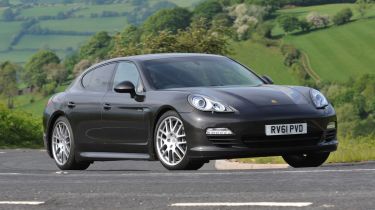Porsche Panamera
Four-door supercar makes a big impression on the road
One thing you are guaranteed to get if you own a Panamera is attention. The five-door Porsche is taller and wider than the BMW and Mercedes, and is imposing to look at and sit in. Combining supercar-style details with brutal proportions, it’s not for those who like to blend into the background. However, in a market where sleek styling and sophistication are key factors, the Panamera doesn’t quite hit the mark.
Porsche’s desire to be different extends to the cabin, where the Panamera stands out from the crowd in a number of important ways. Given the car’s larger dimensions, the interior feels bigger and more accommodating, with a greater glass area allowing more light in. The rear seats mirror the designs of those in front, and give decent amounts of head and legroom.
Up front the seats are supportive but narrow, and while they do without gadgets like the Mercedes’ pneumatic bolstering, they proved the most comfortable of our test trio.
However, travelling in the Panamera isn’t quite as relaxing as it could be. By shunning a central control system for the car’s infotainment devices, Porsche has been forced to pebbledash the centre console and steering column with an array of buttons, sliders and dials. As a result, many are obscured by the chunky gearshift or clustered under the sat-nav screen.
Used - available now

2023 Porsche
Panamera
87,110 milesAutomaticPetrol2.9L
Cash £44,995
2023 Porsche
Panamera
22,752 milesAutomaticPetrol4.0L
Cash £71,800
2020 Porsche
Panamera
59,830 milesAutomaticPetrol4.0L
Cash £48,995
2023 Porsche
Panamera
59,760 milesAutomaticPetrol2.9L
Cash £48,995Under the bonnet is a 3.0-litre diesel engine that develops 247bhp and 550Nm of torque. Sourced from the vast Audi parts bin, it serves up solid performance without ever feeling too strained. We covered 0-60mph in 6.5 seconds, although the in-gear times were no match for the muscular BMW’s.
Our testers also called into question the manual gearbox controls. Instead of paddles, the car features large rocker buttons located on the steering wheel. Not only are these fiddly to use, they defy conventional gearchange wisdom by requiring the driver to push to change up. Fortunately, one area where the Panamera does shine is chassis refinement. Although the car’s sheer bulk makes it unwieldy on narrow country roads, the steering is accurate and perfectly weighted.
The Porsche also rides surprisingly well. Adaptive dampers (which come as part of the £1,052 PASM option) deliver a firmer feel if you want a sportier set-up, while in Comfort mode the car glides across poor surfaces with ease.
With a £62,134 price tag, the Panamera undercuts the Gran Coupe and initially looks decent value for money. However, dig a little deeper and you’ll soon discover that the list of standard equipment is far from generous. For starters, there are those expensive adaptive dampers, while the arch-filling 20-inch wheels fitted to our test car will set you back a further £2,249. Even a rear wiper – pretty essential on a car with a hatchback tailgate – adds £235 to the total. Factor these in, and the case for the Panamera isn’t quite so solid.
Details
Chart position: 3Why? Big and bold Panamera claims Porsche dynamics and affordable running costs. But can it deliver on its promise?







